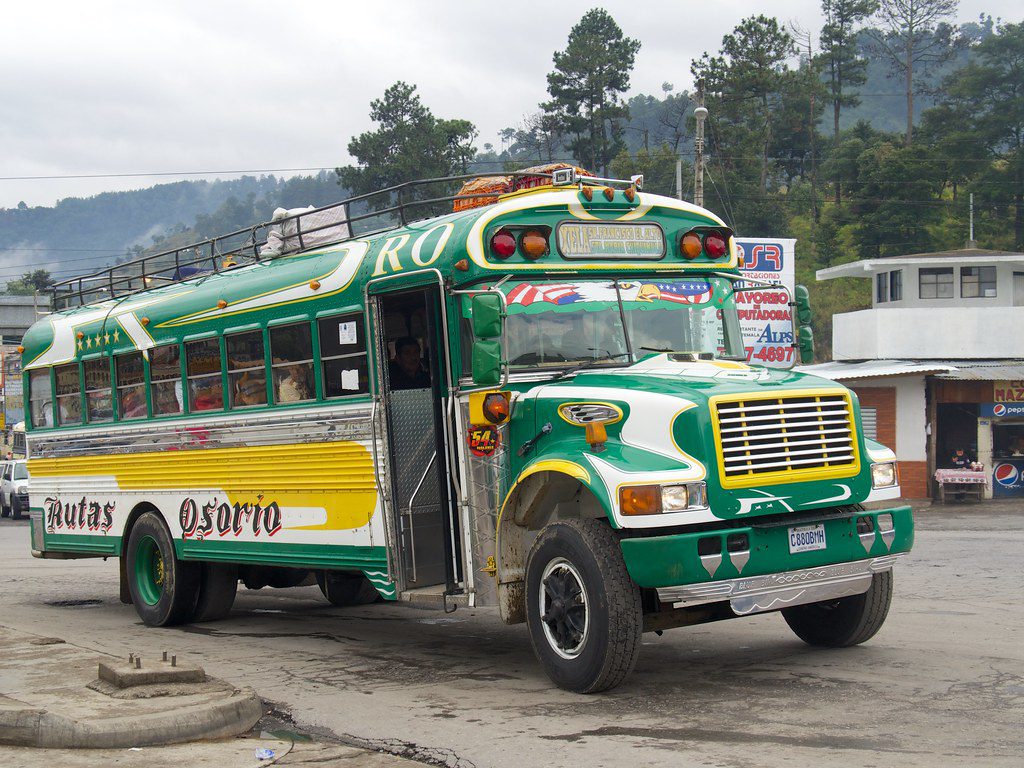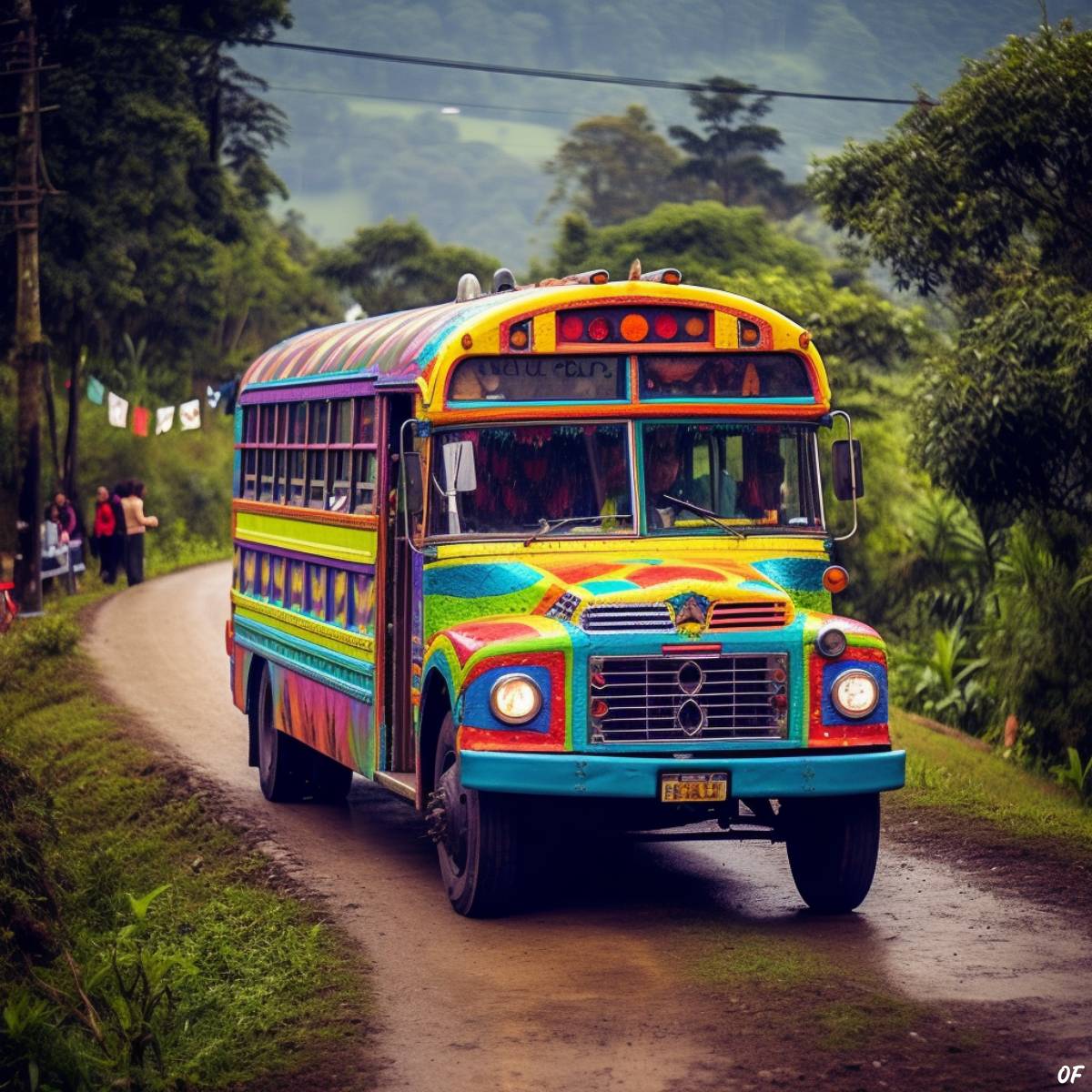A quintessential Guatemalan experience, the adventure aboard a chicken bus, or camioneta as locals affectionately call it, is steadily becoming an essential part of the tourist itinerary when visiting this vibrant Central American nation. If you’ve previously dismissed bus travel as mundane, drab, or discomforting, prepare to have your perceptions radically reshuffled. One may ask: what exactly is a chicken bus, and why does it inspire such intrigue and wonder? Allow us to unravel the colorful tapestry of this unique travel phenomenon.
Venturing across the stunning Guatemalan landscape in an old Bluebird school bus, often imported from Canada or the USA, is anything but ordinary or tiresome. These buses, having ended their tenure in North American school districts, find a second vibrant life here, pulsating with the rhythm of Guatemala. No longer the familiar plain yellow, they undergo an extravagant transformation, adorned with bright paints and intricate designs, becoming a carnival on wheels that stands out against the backdrop of lush, green hills and cobblestone towns.
As for the comfort level, well, that’s a narrative that varies from one passenger to another. But even within the squeeze of three passengers to a two-seater bench, amidst the chaotic cacophony of local chatter, pulsating Latin music, and the occasional cluck of a live chicken, there is a certain charm. This unlikely fusion of color, sound, and motion crafts an experience that is, at its core, unmistakably Guatemalan.
This is not just a form of transportation; it’s a journey through the beating heart of the Guatemalan culture and lifestyle. From the friendly vendors who board at each stop, selling everything from sweet mangos to warm tamales, to the eye-catching scenery unfurling outside the window, each moment offers a new story—an authentic snapshot of Guatemala’s pulsating life. So, fasten your seatbelts—or rather, grab onto whatever you can—as we delve deeper into the thrilling odyssey that is the Guatemalan chicken bus experience.

Repurposed school buses
There’s an iconic, unmistakable image associated with North American school buses: their substantial size, unmissable canary-yellow color, and an inherent sense of orderly routine. However, when these buses reach their retirement in North America—often a decade into service or after covering a good 150,000 miles—they begin an audacious second life in the lower parts of the Americas, a life that is anything but ordinary.
Sold at auction, these venerable vehicles embark on a thrilling journey southwards, where they’re met with an unexpected transformation. The once prim and predictable buses morph into vibrant beasts of burden known as “camionetas.” Gone is the understated yellow, replaced with an explosion of colors and “go faster” stripes that streak across the metal canvas. Windshields morph into a collage of stickers, often bearing religious mantras—an intriguing blend of the sacred and the profane that hints at the thrilling adventure that lies within.
While the new aesthetic could already raise eyebrows, it’s the interior overhaul that truly signals the departure from their previous life. With a keen eye on profit, bus operators often squeeze in more seats than the original design intended. This results in a drastic reduction in legroom that could turn even the most stoic traveler into a fervent chanter of those mantras adorning the windows.
And yet, amid the cramped quarters and cheek-by-jowl camaraderie, the mundane becomes a memory. Each chicken bus ride unfolds as a unique journey that sways to the rhythm of local life. While comfort may sometimes take a backseat, the vibrant spirit of the Guatemalan culture prevails. Indeed, routine is a thing of the past, replaced by an unforgettable mix of color, noise, and vivacity that is the hallmark of the chicken bus experience. So, bid adieu to the familiar and embrace the extraordinary; welcome to the world of Guatemala’s camionetas.

For those pondering how to navigate the chicken bus system, the path is less a well-marked highway and more a winding, unpaved country road. The same essence of Guatemalan spontaneity that lends the chicken buses their unique charm also contributes to their seemingly enigmatic schedules, making them as unpredictable as a sudden summer storm. If you’re considering a chicken bus ride through the labyrinthine streets of Guatemala City—consider again. The city’s teeming chaos can quickly spin you off course, depositing you in an unexpected locale at an equally unforeseen hour.
It’s crucial to dispel any misconceptions: despite the whimsical name, camionetas are not your conventional means of transportation. Should you have a tight schedule to adhere to, relying on a chicken bus might not be the most prudent course of action. Time, in the realm of the chicken bus, tends to follow its own rules. Paradoxically, you might find yourself reaching your destination much quicker than anticipated. When we say quicker, we are indeed referring to breakneck speeds, as drivers put the “go faster” stripes to good use.
Yet, it’s precisely this unpredictability, this dance with the unknown, that makes the chicken bus experience so captivating. You’re not just traversing geographical distance; you’re immersing yourself in a vibrant tapestry of Guatemalan culture, painted with hues of human connection and seasoned with the spice of adventure. So, while the chicken bus may not be the key to punctuality, it just might be the gateway to an enriching, unforgettable journey. Buckle up and brace yourself for a ride that’s faster, more colorful, and far more thrilling than anything the usual roadways have to offer.
Not for the faint-hearted
The drivers of these chromatic chariots, it must be noted, possess a decidedly cavalier approach when it comes to passenger safety. Picture this: you’re coursing along the precipitous mountain roads of Guatemala, negotiating dizzying hairpin bends, as the air is filled with the cacophony of honking horns and colorful local expletives. Meanwhile, abrupt braking sends shockwaves through the bus, swaying it perilously close to the edge.
But the heart-stopping moments during the journey aren’t the sole source of trepidation. Both tourists and locals alike often find themselves casting anxious glances towards their belongings rather than the breathtaking landscapes unfurling outside the window. The reason? Amid the jostling bustle of the crammed-to-capacity chicken buses, luggage can be “misplaced” with alarming ease. Furthermore, whispers circulate about instances of bags being stealthily slashed and treasured possessions pilfered. The best advice? Keep your wits about you, cling to your comfort zone as if your life depends on it (sometimes, it might), and never let your belongings escape your vigilant watch.
And yet, despite the elements of risk, the chicken bus journey remains an essential Guatemalan experience—one you wouldn’t dream of missing. Amid the whirlwind of sounds, the pungent mingling of aromas, and the vivid explosion of colors, you encounter the authentic heartbeat of Guatemala. This is not a mere ride, but a sensory overload that plunges you into the country’s cultural core. So climb aboard and buckle up for a journey that will etch itself into your memory, a tale so vibrant and brimming with life that you’ll be retelling it for years to come. Just remember to hold onto your seat—and your suitcase.


